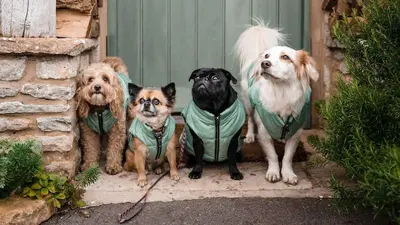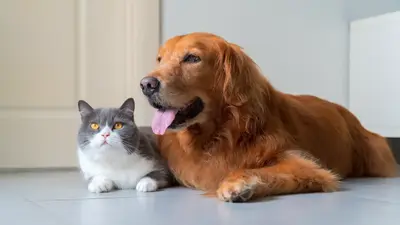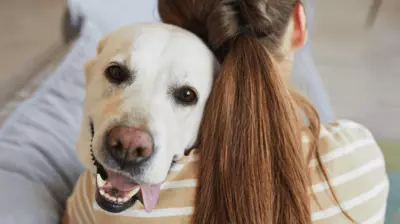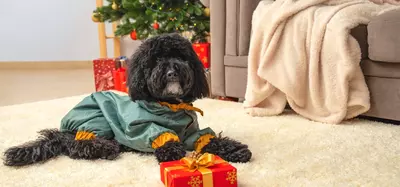How to Travel with a Dog in the Car
- 31 May 2023
- 11m read

Getting ready to hit the road with your pup by your side? Whether you're embarking on a long journey or a short escapade, ensuring that your pooch is safe and comfortable is super important to guarantee a tail-wagging adventure.
We’ve put together lots of valuable tips and safety measures to make car travel a smooth experience for you both. From preparing your pooch for the ride to choosing the pawfect car safety equipment, we've got you covered, with Butternutter-approved advice.
Car Training a Dog
Car training is a really important part of getting your dog used to regular travel. As marvellous as your pup may be, don’t expect them to embark on their first car journey without some hiccups. Their mind has to process a lot.
Why has my human put me inside this foreign object and more importantly, why can’t I sit on their knee?
Take your pooch on short trips to familiarise them with the experience, making sure to give plenty of treats and praise throughout.
A good practice run might be when you take them to the vet for their check ups and vaccinations, but don’t make this their only experience as it will become their primary association with the car. You should also take them to new walking routes using the car. This is not only great for experience but think of all the new smells and friends that they can encounter miles away. Bottom sniffs galore.
Never leave your furry family member alone in the car. Extreme temperatures, in addition to the stress of being left alone, can be paw-tentially very dangerous.
How to Secure Your Dog in the Car
To prevent any ruff situations from happening, make sure your pup stays secure when inside the car. Avoid letting them roam freely, as it can lead to driver distractions or accidents. More importantly, it is actually illegal in the UK, as per Rule 57 of The Highway Code - ‘make sure dogs or other animals are suitably restrained’.
Instead, use a seat belt and harness in the backseat or place them in a well-ventilated travel crate. This way, your dog can enjoy the ride without interfering with your driving.
The team at Butternut Box have put together a list of our favourite pooch products to keep your dog safe whilst travelling in the car. All of these have been tried, tested and given the lick of approval by our pups.
Dog Ramp for Car
The first step to securing your dog in the car… is to actually get them inside the car. Chihuahua and Cavapoo owners may be left wondering how this could be so difficult, but spare a thought for those attempting to lift a 35kg German Shepherd.
Using a ramp to get your dog into the car is a much safer alternative. Ramps should also be used to help older dogs, or those with mobility problems, to get into cars.
These foldable dog steps from PiuPet are suitable for both small and large dogs alike, holding up to 80kg. It can also be used universally with all vehicles as it has a height-adjustable mechanism.
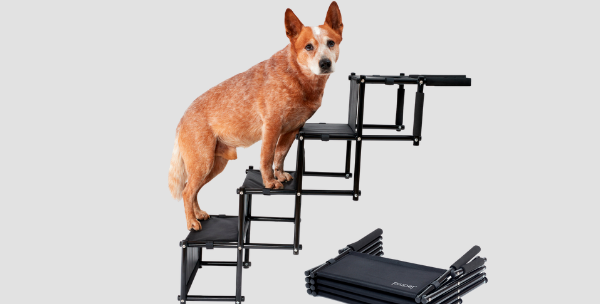
When searching for a suitable dog ramp that would make life easier, a lot of our pet parents mentioned that they wanted a ramp which they could easily pack into the car, for use away from home. A lot of the ramps on the market are incredibly bulky. So, when they found this one which weighs only 5kg and can be folded up and placed into a carry bag, it was a no-brainer.
Dog Travel Bed
A comfortable dog is a happy dog. It is likely that your dog will find car seats very rigid and uncomfortable, making it difficult for them to lie down and relax. We would recommend investing in a dog bed or pad for the backseat
This Travel Dog Pod from Luther Bennett is pawfect for ensuring that your dog can unwind in style. Made up of five padded cushions with tall outer edges, your dog will be able to hide, sit up and relax like an armchair. This is sure to make them feel more comfortable, confident, supported and stress-free when travelling. The extra-strong, woven handles mean that you can easily pick your dog up and transfer them to and from the car.

The bed is made from durable, nano-nylon fabric that can withstand rips, tears, scratches and liquids. It can also be strapped onto a seat, compatible with both front and back seats, to keep your pooch extra-secure.
Dog Car Crate
For some pet parents, we understand that you’d prefer to have your pooch ride in the boot of the car. It is completely safe to travel with your dog in the boot, but it is recommended that you use a crate with a barrier to the car interior.
A crate will keep your dog safe in the event of an accident, especially important for rear collisions. Getting a crate with a gate will prevent your dog from getting through the main part of the car, which can be incredibly distracting to a driver and leads to accidents happening.
Our go-to option for car crates are from TransK9. Their crates are independently crash tested, covering both front and rear impacts as well as drop tested to check their vulnerability to a roll-over accident.
The crates are all coated using SteriTouch® to keep dogs safe. SteriTouch® is a silver-based antimicrobial additive which kills 99.99% of bacteria such as Salmonella, MRSA, and E.coli. SteriTouch® also helps prevent nasty odours as well as the growth of mould and fungi within the crate itself.
There are crates available to fit all vehicles, including vans, in single or double frames based on your preference. They are a little on the pricey side but come with a 10-year structural warranty.
If your dog is crate trained, they are much more likely to adapt to a boot crate quickly. We would recommend placing your dog in one of these from a young age to ensure that they are comfortable whilst travelling.
Dog Car Seat Belt
This Dog Car Seat Belt Headrest Restraint by Petzana is a firm favourite. This is a great interchangeable restraint as it gives you the option to strap your pup in via the headrest, or via the seatbelt. When you’ve got a car full of people and pooches you’re unlikely to have enough seat belts to keep everyone safe and so you can opt to restrain via the headrest instead.
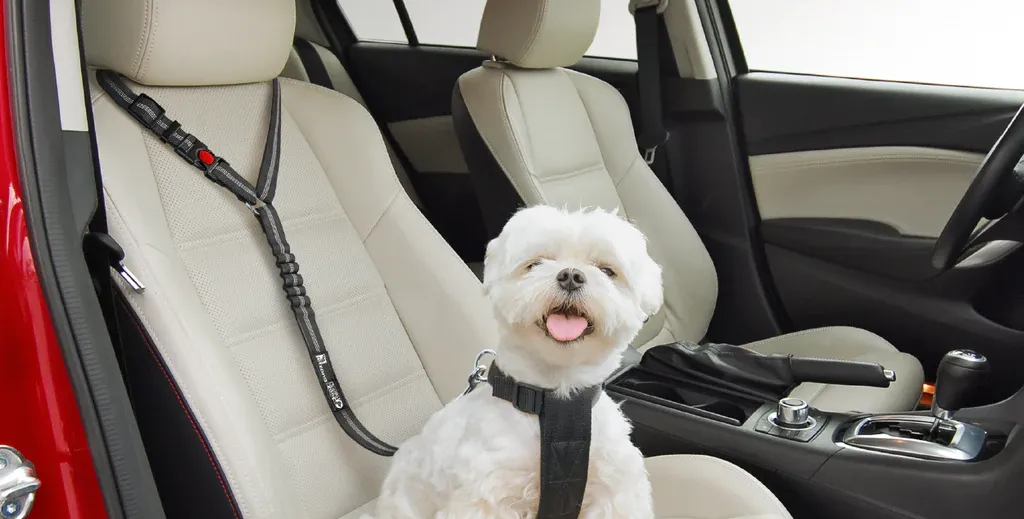
It is compatible with any vehicle thanks to the adjustable straps. This also means you can adjust the length to suit any dog size and decide how far you want them to be able to roam around the backseat. Simply clip your dog’s harness to the restraint using the 360° swivelling snap and they’re good to go.
This product should not be used with collars, but harnesses only.
Crafted with heavy duty nylon and metal, this harness is available in black, grey, blue, purple, green, red, orange and pink. There’s a colour to flatter every pooch.
Car Seat Coverings for Dogs
As much as we love our pups and cherish when we can share our adventures with them, it can put a damper on the festivities when you’re left with a car full of dog hair. Sometimes enough to resemble another pooch- we see you Labradors.
Thankfully some clever clogs have come up with a way to keep pooch and parent happy.
Your choice of car seat covering really depends on how the backseat is going to be used. The hammock-type of car seat covers are great if your dog is going to have the whole space to themselves. However, if you also want people to be able to sit in the seats alongside your pup, then you should opt for more of a fitted-style car seat cover.
Fitted Car Seat Cover
This fitted dog car seat cover from AMZPET is a personal favourite that won’t break the bank.
It is designed to fit across the back seats of your car with a simple 5 minute installation. All you have to do is place it on the seat, loop the straps around the headrest and secure the seat anchors. It even has velcro seat belt slits, giving you access to all three seatbelts, as well as the ability to unzip the middle seat section.
Fully waterproof, non-slip and scratch-proof, it can withstand even the muckiest and most restless of pooches can’t defeat it.
It is available in four different sizes: universal, universal (with isofix), compact and spacious.
Hammock-Style Car Seat Cover
Alternatively, this dog car seat cover from AMZPET is a 3-in-1 car hammock, boot cover and back seat cover.
It comes with all the same benefits as the fitted car seat cover with the added benefit of protecting your car footwells from getting dirty too. The obvious drawback is that you can’t also have humans in the back of the car when using this. Paw party only.
Minimising Risk
As the old saying goes, prevention is the best cure and this definitely applies here.
Keep potential hazards, such as loose objects and food out of your dog’s reach. You should also ensure that doors remain closed. Windows should also remain closed where possible, but if they need to be opened, keep the gap to a minimum.
Avoid letting your dog’s head hang out of the window. Yes, it is hilarious for passers-by and we would be lying if we said it wasn’t one of our favourite sights. But the reality is that it can be quite dangerous and your dog risks injury from passing objects or debris.
You should also pack a first aid kit specifically made for dogs, including items such as bandages, antiseptic wipes and tweezers for tick removal. Research vet clinics along your route and save their contact information in case of emergencies.
Additionally, always have a supply of water, food and treats, as well as any necessary medications, readily available for your pup's well-being.
Can Dogs Get Car Sick?
Yes, dogs can get car sick.
Unfortunately just like us humans, for some pups travelling just doesn’t sit well with them and they may experience some motion sickness while in the car.
How to Help Dogs with Car Sickness
To help alleviate tummy troubles, avoid feeding them a big meal right before hitting the road. Instead, opt for a light snack a few hours before setting off and leave the big meal until after the journey has finished.
Maintaining a smooth and steady driving style to keep abrupt movements to a minimum can help avoid exacerbating their discomfort. Leave the ode-to-Hamilton for a dog-free journey.
Consider talking to your vet about over-the-counter medicine or natural supplements that can help ease their queasiness.
Can I Leave My Dog in the Car?
No, you cannot leave your dog in the car.
Leaving your dog in a car in the UK is generally not recommended and, in some cases, can be illegal and dangerous. Even on mild days, temperatures inside a parked car can rise rapidly, leading to heatstroke and potentially fatal consequences for your dog.
The UK's Animal Welfare Act 2006 makes it an offence to cause unnecessary suffering to animals, which includes leaving them in conditions that could harm their health or well-being. If your dog suffers harm or distress due to being left in a car, you could face legal consequences and potential animal cruelty charges.
If you need to run errands or make a quick stop, it's best to leave your dog at home where they will be safe and comfortable. If you must bring your dog along, ensure someone can stay with them or make arrangements to take turns taking care of your dog outside the car.
Prioritise your dog's well-being and safety by avoiding leaving them unattended in a car.
Why Does My Dog Shake in the Car?
Some pups may experience anxiety or stress while travelling in cars and this often presents itself in the form of shaking and whining.
To help them feel more at ease, create a calming atmosphere by playing soothing music or using pheromone sprays or diffusers specifically designed for dogs. Familiar scents, such as their favourite blanket or toy, can provide a sense of security in an unfamiliar environment. Chew treats will also help to keep them occupied.
Why Does My Dog Pant and Drool in the Car?
There are a number of reasons why your dog might be excessively panting and drooling in the car. It's not necessarily something to worry about, as dogs usually do both of these things to simply regulate their temperature. However, it could also be a sign of anxiety, stress, nervousness or excitement. There’s a few things that you can do to keep panting and drooling to a minimum.
Be sure to keep a fresh flow of air moving throughout the car
Crack open the windows just enough to let the scents of the great outdoors waft in, providing a snifftastic experience for your pooch. Alternatively, utilise the car's air conditioning to maintain a comfortable temperature.
Ensure that they’re hydrated
Keeping your pup's thirst quenched while on the road is very impawtent. Bring along fresh water bottles and a spill-proof bowl to keep their spirits high.
Make stops throughout the journey
Schedule regular stops for toilet breaks and a chance to stretch those paws. Choose pet-friendly rest areas or parks ahead of travel to ensure a delightful experience for both you and your pup co-pilot. This will help them to release pent-up energy with some much-needed mental stimulation, preventing restlessness for the rest of the journey.
Remember to always keep them on a leash and clean up after them to be a responsible pet parent.

